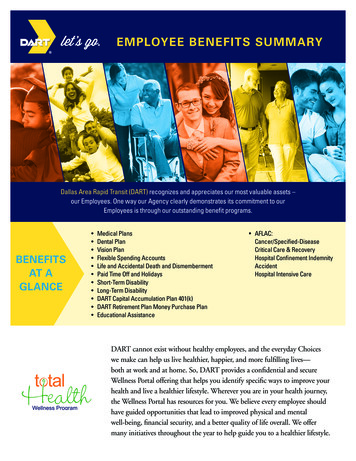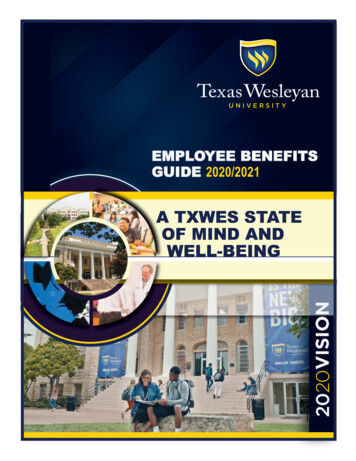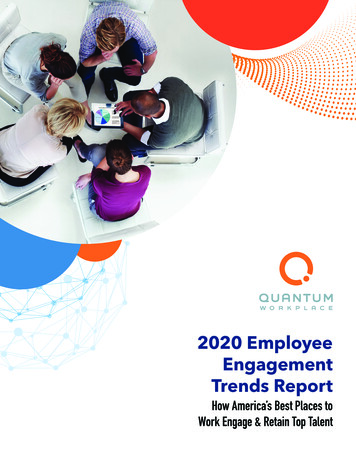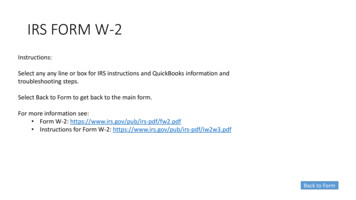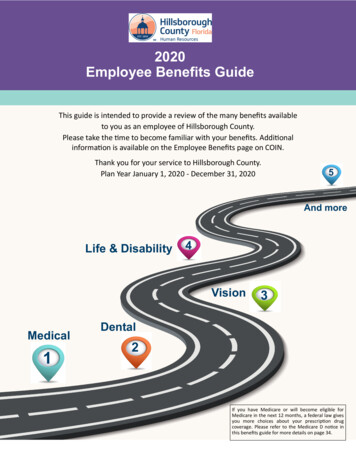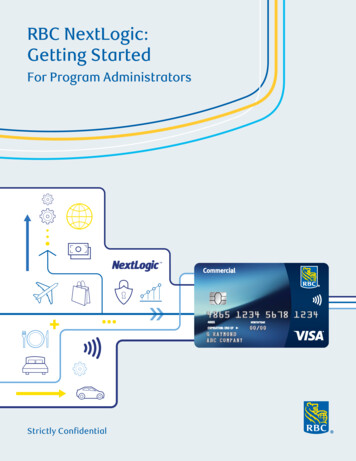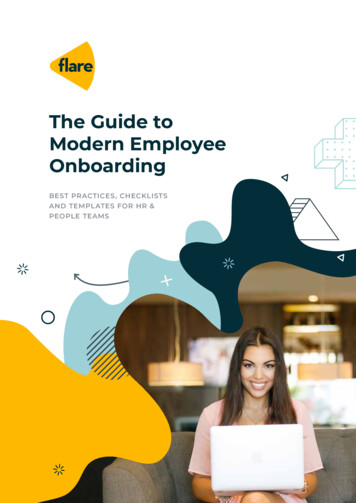
Transcription
The Guide toModern EmployeeOnboardingBEST PRACTICES, CHECKLISTSAND TEMPLATES FOR HR &PEOPLE TEAMS1
ContentsIntroduction 3Planning & Preboarding 9First Day 16First 30 Days 22First 60 Days 28First 90 Days 33A Strategic Perspective 37Onboarding Checklists 38Email Templates 462
IntroductionEmployee onboarding is one of the most crucial steps youcan take to welcome new employees and set them up forsuccess in your company.An onboarding program helps new employees settle intotheir role, team and company. With the help of training,the right resources and a plan, you can reduce the stress andanxiety of new employees’ first days, while at the same time,improve business outcomes. An effective onboarding programis the number one factor in increasing productivity, keepingemployees engaged and retaining talent in the first 90 daysof an employee’s new job. When done well, it promotes a senseof belonging, loyalty and excitement.3
Benefits of OnboardingIncrease productivityOnboarding shortens the amount of time it takes foremployees to be productive in their position. Studies showstrong onboarding programs boost productivity by 70%.Employees who experience strong onboarding feel moreconfident in carrying out the tasks expected of them. This leadsto increased productivity and performance. It also reduces theamount of time taken to connect and build relationships withcolleagues, making new employees more comfortable reachingout to their team on their own.4
Improve employee experienceImagine your best-case scenario. What feedback wouldyour new employees share with you about their onboardingexperience? What experiences and knowledge will newemployees walk away with when they finish their onboardingjourney? When you start with the end in mind, you can begin toarchitect the experiences and build moments that matter in theonboarding process.Effective onboarding programs incorporate intentionalemployee experiences, designed to acclimatise new employeesto their new environment and set them up for success inmaking early contributions to the organisation. Effectiveexperience-driven onboarding leads to greater job satisfaction,greater motivation and a greater commitment to a neworganisation.Increase retentionA structured and effective onboarding process increasesnew hire retention by 82%. Research by Glassdoor foundthat employees who rated their onboarding experience as“highly effective” were 18 times more likely to feel highlycommitted to their organisation.5
Onboarding in Today’sModern Work WorldWith the advent of hundreds of HR technology solutions acrossthe globe, organisations are shifting away from time-intensivemanual HR administration and towards automated, experiencedriven onboarding programs: a new standard for onboarding ison the rise.Traditionally, organisations have focused heavily on compliancedriven requirements for onboarding — including contracts,pay details, superannuation forms, visas and basic setuprequirements for employees. High amounts of HR resource isdedicated to paperwork, email back and forth, and spreadsheetdriven workflows.Now, organisations are shifting towards modern onboardingpractices: automated workflows for administrative tasks and6
a deeper focus on employee-centric and experience-drivenonboarding programming. Organisations that are making theshift are seeing onboarding efficiency improve by over 10 times,and teams benefitting from a renewed focus on higher valuework.In one example, two HR managers at Sephora Australiareduced their employee onboarding administration from twoweeks to 60 seconds, after digitalising their onboarding process.They implemented a streamlined and compliant onboardingprocess that digitally verified personal details, certifications,bank, tax and super information, so they could reallocate theirtime to other initiatives.Modern onboarding is about leading with employee experience.When you shift your onboarding standards at your organisation,you can invest more time into building meaningful onboardingexperiences and spend more time engaging new employees.This guide is for teams that want to level up their HR operationsthrough modern onboarding programming, practices andexperiences for their employees.7
How to Build anEmployee OnboardingProgram8
Planning &PreboardingPlanning and preboarding are the foundations for youronboarding program because they set the tone foremployees’ early experiences with your organisation.Consider the impact that an effective or poor onboardingexperience has on every new employee who enters yourorganisation. Investing time to plan out your employeeonboarding program can have a positive ripple effect on youremployees and organisation. The onboarding experiences youcreate will impact business metrics, such as employee retentionand turnover, and your reputation as an employer of choice.So, what are some steps you can take to plan out youronboarding program?9
Outline your onboarding goalsBuilding an onboarding program with the end in mind meansworking backwards from day 90 to your new employee’s first day.Putting new employees first makes them feel that they made theright choice by joining your company. Onboarding isn’t a race,it’s a journey. Pace and spread out the information over time.Map out the employee onboardingjourneyMapping out the employee onboarding journey is the startingpoint for a strategic and experience-driven onboarding program.When you thoughtfully craft your onboarding program withmoments for check-in, digital touch points and experiences,you begin to build consistent, feedback-driven and measurableexperiences for all new employees.Engaging managers in this process will lead to a smoothertransition into your company and reduce the anxiety that comeswith change for both new and existing employeesAutomate your onboardingAutomating your onboarding program helps streamlineefficiency, reduce costs and create more meaningful workfor your teams. When you eliminate manual onboardingadministration processes with automation, you free up timeto focus on higher value tasks.10
Seven Steps to Building anEffective Onboarding Plan1.Outline your onboarding goals2.Map out key milestones and moments that matter along theonboarding journey3.Build your programs, onboarding decks, documentsand training materials4.Identity how you will measure success at different pointsalong the onboarding journey5.Identify ways to scale, modernise and automate yourprocess6.Standardise and improve your processes incrementally7.Regularly report feedback and results of your onboardingprogram to key stakeholders11
PreboardingOnboarding starts before day one. In fact, it begins the secondyour new hire has officially accepted your offer. “Best-in-Class”companies are 54 percent more likely than others to start theonboarding process prior to the first day.We call this stage the preboarding process — everything you doto get your new team member situated prior to walking in thedoor for their first day. This sets expectations, allows new hires toadequately prepare, and instills comfortability and confidenceas they know what’s to come.12
New hire paperworkCompliance is important for every business, and you can beginfilling out required documents and forms before they enter yourstore. You’ll need basic information, including name, address, dateof birth, email, and emergency contact. New for 2020, employersmust provide new hires a copy of the Fair Work InformationStatement, and it’s also recommended to provide a copy of theawards documents.A quick note on types of retail employees: In Australia, employeescan be classified as full-time, part-time, and casual. In the retailsetting, these employees are typically casual workers. Fulltime and part-time workers have a fixed term contract and arescheduled consistently each week. Casual workers have a moreflexible arrangement — instead they have no guaranteed workinghours, may be scheduled irregularly, don’t receive paid leave, andcan end employment without notice (unless otherwise agreed toin writing).You’ll also need to provide the following in the onboardingprocess for new employees:Employee contract and confidentiality agreement —you can use templates from the Australian Fair WorkOmbudsmanBank account details (for direct deposit wages)Tax file number (TFN) declaration form (NAT 3092)— employers are required to give this to new hires andsubmit it to the fund within 14 days of receiving it from theemployee13
Superannuation standard choice form (NAT 13080) —designate an employer nominated fund, which is a defaultsuper fund for when an employee can’t or doesn’t choosetheir ownA copy of their driver’s license or photo identificationWorking visa (for non-Australian citizens)You can also distribute, or make available: Official job title and description Employee handbook Code of conduct Store policies and procedures Information about your brand, products, and customers Store and working hours Break schedules Benefits Health declaration outlining special medical requirements Holidays and leave Where to go on day one and who to ask for on arrival Dress code Keys or access card Schedule or agenda for first day Store map Employee portal access14
Important: This can be incredibly tedious, boring, and uninspiringfor your new hires. It’s important to spell out why you need thispaperwork, and how it benefits them specifically. For example, ifthey provide their banking information ahead of time, they’ll gettheir first paycheck more quickly.In fact, businesses that do increase onboarding efficiency by85 percent. You can then centralise all of the documents andonboarding materials for easy access by both managers andassociates. Not to mention, a digital onboarding programmeensures confidentiality. Workplace regulations companyEmploysure uses Flare HR’s digital onboarding tools as anend-to-end employee onboarding process to track employeesthroughout their tenure.Get to know your new hireAsk new hires to fill out a questionnaire with some informationabout themselves, including where they’re from, their interestsand hobbies, and career aspirations. You can also conduct anentrance interview on their first day. This information will serve asa base for many onboarding steps to come.15
First DayCan you recall a first day at a new job?Every person has only a limited numberof first days at a new job in their lifetime,so you have a rare opportunity to createa memorable moment in your newemployees’ professional lives.16
Personalise their welcomeCreate personalised welcome experiences for new employees,based on the knowledge you have of them that hasaccumulated throughout the interview process, from hiringmanagers or from personal fun facts acquired through yourdigital onboarding processes.Here are some ideas for personalising your welcomeexperiences: In your employee welcome address or message, includea positive acknowledgement or funny experience that stoodout in the hiring process Build a set of common questions that all new employeesanswer. For example: ‘Tell us about a highlight in your life,’or ‘what’s your most embarrassing story?’ Create a moment of delight with a gift or experience thatis unique to themWhether it’s a gift or a kind gesture, the delivery of a personalisedwelcome experience demonstrates appreciation for the employeesjoining your organisation. That’s what will be remembered.Personalising the welcome for new employees shows that yourorganisation cares about them. When employees feel cared aboutand experience a sense of belonging on their first day, you’re offto a good start.17
Introduce a buddyIntroducing an onboarding buddy system is one of the mosteffective ways to help new employees quickly learn about thecompany’s culture, its social norms and nuances that only comewith experience and insider knowledge.An onboarding buddy is like a new employee’s first friend:a different relationship to that between a manager, coach ormentor and a new employee. An onboarding buddy is mostlikely to be a peer or someone in a different department orteam.Benefits of a buddy system Increases the ramp up and productivity of new employees Enhances the experience of new employees Fosters friendships and a sense of belonging Gives the buddy an opportunity to lead, develop peers andshare their knowledgeSetting up an onboarding buddy system will help youremployees acclimatise to their new roles quickly.By ensuring a clear point-of-contact that can guide themthrough their first few months in the job in an informal setting,you’re providing a structure for new employees to feel morereassured, confident and comfortable in the workplace,which ultimately leads to better productivity and greateremployee satisfaction.18
Complete onboardingdocumentsAddress the importance of completing compliance documentsand onboarding paperwork, before the start of the secondday (if not already completed prior to their first day). There’snothing more tedious and uninspiring then doing the back andforth dance of employee documents between new employees,HR and payroll.Encourage the completion of those documents and get themout of the way. You want your new employees motivated,enthused and focused on the onboarding program aheadof them.If you’re an Australian business, there are ways that youcan automate document completion through paperlessonboarding for free and store all signed contracts andemployee documents in one place, prior to an employee’sfirst day.19
Employee Onboarding atSephora AustraliaSephora Australia reduced their employee onboardingadministration from two weeks to 60 seconds, by shiftingaway from manual onboarding administration to paperlessonboarding with Flare HR.With over 400 employees to support,Sephora had just two people managingHR administration in Australia.20
Sephora experienced high employee turnover and highonboarding volumes, as they mostly employ part-timers andcasual workers, with peak seasons such as summer. Theirmanual approach to HR administration was tiresome and timeconsuming.In search of a better way, Sephora Australia implemented astreamlined and compliant onboarding process that digitallyverified personal information, certifications, bank, tax and superforms with Flare HR. The paperless onboarding journey becomeentirely employee-led; the Sephora team only had to add themto the journey and ensure completion.Sephora reduced their onboarding administrationtime by over 99% and saved 40 per employeeonboarded. The HR managers were able toreallocate their time to other meaningful initiatives.Digital paperless onboarding leads to greater operationalefficiency and cost and time savings for teams managing HRoperations. It has paved the way for a new standard of employeeonboarding and enables them to dedicate their time to creatingmeaningful onboarding experiences with new employees.For organisations seeking ways to uplift their onboardingefficiency by 85% with free software, request a demo of Flare HR.21
First 30 DaysThe first 30 days are about setting your newemployees up with the foundations of success,by creating the right opportunities for them to learnand develop.Learning and development requirements andtimelines differ by organisation and by role,but there are ways to foster faster learning anddevelopment that offer value to all workforces andorganisations that you can lead.22
To shape the first 30-day experience, your newemployee onboarding goals should be as follows: To facilitate an environment that new employees feel theycan thrive in To ensure employees gain hands-on experience of their role To keep managers accountable for regular check-insEncourage questionsand initiativeAn effective way to empower new employees to be moreengaged, accountable and motivated about their learning anddevelopment is to encourage them to ask questions often andto take initiative for their own personal ramp up.Encouraging new employees to ask questions — silly questions,difficult questions, repeated questions and too many questions— fosters proactive engagement in their learning, whileat the same time, creating an open, collaborative learningenvironment and speeding up the ramp up process for allnew employees.Encouraging new employees to take initiative for their personalramp up fosters a sense of personal accountability for their owndevelopment. It enlivens their self-awareness and personalmotivation, which helps them engage more deeply with theonboarding experience.23
Ways to encourage questions andinitiative: Have employees write down their onboarding and rampup goals and milestones. Share and review them with peersduring the onboarding journey Setup a meeting at the end of the week, or recurringmeetings, for new employees to ask questions, debrief onthe week and ask for guidance. Encourage employees towrite down their questions or notes, which leads to betterreflection and recall Recognise new employees who speak up and help otherteammates upskill with a surprise kudos, and continuerewarding that behaviour early on. For example, ask them:‘Which of your new peers in this onboarding group helpedyou the most this week? It could help me with training,sharing resources or asking questions that benefitedeveryone.’ Give kudos to that person who’s taken initiative,and share why that’s valued in your organisation.When you create environments for new employees to bemore engaged and feel empowered to own responsibility fortheir own learning, growth and development, you’re enablingpersonal development within each new employee and you’rebuilding a more engaged workplace.Encouraging these behaviours in the early onboarding stageswill set the tone for your employees throughout their lifecycleat your organisation.24
Conduct role-based training oran inductionDepending on the roles and responsibilities of your newemployees, conducting role-based training (e.g. certifications,on-the-job training and upskilling) or induction sessions iscritical for setting employees up for success in the organisation.These hands-on, practical and informative sessions give newemployees a strong foundation for their new roles.Scheduling training and inductions within the first week or so ofemployees joining your organisation helps them upskill early intheir onboarding. From a strategic perspective, consider hiringemployees in cohorts with the same start date, so you can betterline up training and induction timelines.You’re investing valuable resources, money and employees’ timeto support these initiatives. Think through the costs associatedwith training and induction and how you can optimise theseprocesses, save costs and improve these experiences fornew employees.25
Include these sessions in youremployee induction process:1.Vision, mission and business model: your vision andmission, how your organisation grows, how teams worktogether and how your new employees play a role in the bigpicture2.Company values: the values of your organisation and howthey’re experienced by employees3.Team builder or ice breaker: an exercise or experiencethat lets employees experience your culture or values, orthat encourages employees to collaborate and learn abouteach other. Some simple and effective HR tools that werecommend are CCS cards, SY Partner Super Power cards4.Expectations, policies and procedures: lay out workplaceexpectations and codes of conduct5.A talk from leadership: have your leaders make time for newemployees. Examples: set a leadership Q&A panel, request aCEO address to new employees or make a video, and encourageleaders to spark candid conversations with new employees26
Set up regular check-insEnsuring that new employees have regular check-ins with theirnew managers during their onboarding experience is the firststep to building a strong employee and manager relationship.You can help managers become more aware of their impact onnew employee onboarding and set an expectation that regularcheck-ins and feedback will dramatically influence the learningand development of their new team members.The value of check-ins to managers: Set a regular rhythm for communication, feedback andgoal discussions Learn about employees and how to motivate them Earn trust from employees early onThe value to employees: Receive coaching and align on expectations Receive feedback and continuously develop Build trust with manager early onStrong employee and manager relationships lead to improvedemployee engagement, increased productivity and promotionof continuous learning and collaboration.27
First 60 DaysThe first 60 days are about creating goals andsetting expectations for the next 30 days.During this stage of onboarding, you want newemployees to experience some early personalwins, so they can begin to see momentum intheir new role.28
The aims for this period for HR and other managersshould be: Build realistic and achievable ramp up goals Set expectations for working relationships, rhythm and tasksto be completed Make giving and receiving feedback a priorityYour role is to be present as a strong business partner to yourmanagers. Managers are the greatest influencers on thegrowth and development of new employees. They set the tone,expectation and vision for new employees. You can guide andenable managers with training, best practices, coaching on whythis is important and how they can mentor new employees.Common methods include facilitation workshops, tools andtechnologies, checklists and regular check-ins.Set near-term goalsSetting goals to achieve a near-term milestone helps newemployees build momentum and paves the way for them tocelebrate their first wins at your organisation.Running goal setting sessions and enabling managers withtools and best practices will help your organisation achievebetter alignment and growth. Consider training on proven goalsetting frameworks like the OKR framework made popular byGoogle or Zig Ziglar’s Goalsetting Canvas.29
Here are a few best practices for goalsdevelopment: When setting goals with employees, build S.M.A.R.T goals— goals that are specific, measurable, attainable, realisticand timely. You should be able to score goals out of 100. To help employees achieve these goals, check in regularly ongoal progress. Holding employees accountable and showingthat the goals and outcomes matter will demonstrate thatgoals are taken seriously, and thus, employees will be moremotivated to take them seriously too. When a goal is achieved, recognise the achievement andcelebrate the early win. Recognising early achievement willbuild employee motivation, increase engagement and seta rhythm for momentum and performance.Set expectationsSetting clear expectations about a role and communicatingthose expectations frequently to new employees will help themramp up more quickly. Your role is to coach managers on theimportance of expectation setting, and help them be awarethat a new employee’s former manager likely had differentexpectations than they do. You can help managers in yourorganisation with expectation setting by coaching them on: Becoming clear about expectations by writing them down Gaining agreement and commitment from the employeeand the manager 30Repeating expectation conversations, as needed
When managers think that a new employee isn’t the rightfit for a role, it can often be related to different expectations,poor expectation setting and poor communication of thoseexpectations.Employees who are given clear expectations perform betterand ramp up faster because they know what’s required of them.Coaching managers on proper expectation setting will helpeveryone involved in the onboarding process.Give and get feedback oftenGiving feedback and getting feedback frequently helpsemployees, managers and the organisation develop andimprove faster together.Feedback helps us gain multiple perspectives into situationsand helps us see the bigger picture. When we implementfeedback rooted in employee insight, positive changes can bemade that impact the organisation.Giving feedback to employeesMost employees want feedback on their work and performance.Constructive, specific feedback helps people learn, improveand grow. It helps people see more possibilities and areas forimprovement, offers a new way of thinking and helps employeesdig deeper.31
Getting feedback from employeesGetting feedback from employees helps managers developpersonally and helps the organisation to improve when thefeedback inspires a change. Here are some common ways youcan help facilitate consistent feedback collection: Employee pulse surveys Performance reviews Regular check-ins with business partners and managersFind ways to make feedback loops a regular rhythm within yourorganisation. When you build a feedback culture, employeeengagement increases, and your organisation will reap thebenefits of more perspectives to fuel better decisions.32
First 90 DaysThe first 90 days are about your new employeesdemonstrating performance. During this stageof onboarding, you want new employees to feelconfident in performing in their roles.They should know what success looks like andunderstand that they are expected to deliver intheir role.33
The aims for this period for HR and other managersshould be: Review performance and goals and share feedbackconstructively Remove roadblocks for employees Develop your employeesReview performanceand goalsReviewing performance and goals and sharing feedback withnew employees will help them reflect on where they did welland where they can improve.Effective performance reviews require managers tocommunicate feedback constructively and effectively andin the right environment. If you have first-time managers inyour organisation, it’s worth training and preparing them forthese conversations.If regular feedback and check-ins have been delivered well,there will be no surprises for your new employees or managers.Consider conducting a performance review refresher session oroffering coaching, especially for first-time managers.34
Remove roadblocksRemoving roadblocks for your employees helps themfocus on the job to be done, and away from distractions.Roadblocks cause challenges to performance. They createdemotivation and frustration among employees.Roadblocks can be team- or organisation-based issues (internalteam challenges, policies, procedures or management practices)that cause conflict or lack resource, or mental health issues(stress, anxiety or depression).Managers can play a role in addressing and finding solutions forroadblocks, whether it be directly, making an immediate changeor, promoting and supporting employee wellness more broadly.For the latter, you can play a role in promoting employeewell-being across the whole organisation.Some common ways to promote employee wellbeing are tore-communicate employee benefits, invite benefits providers into speak to employees and promote wellness initiatives acrossyour organisation.35
Develop your employeesDeveloping your employees helps build loyalty, and loyaltyincreases employee retention, satisfaction and productivity.When employees know that their manager and organisationcare about their development, they become more loyaland engaged.Here are a few ways you can support employee development: Coach and practise soft skills development with employees Offer job-specific training or learning opportunities Help employees find mentorship Provide access to online learning tools such as Go1, Lyndaor UDemyConstantly promoting employee development in yourorganisation creates a culture of learning, which fuels thegrowth cycle and iterative improvements that will enhance yourorganisation. Employees will feel more motivated to learn newskills and acquire new knowledge when everyone is operatingin a growth mindset.36
A StrategicPerspectiveBuilding an effective onboarding program that gains tractionwithin an organisation requires broader alignment from yourexecutive stakeholders, managers and employees. Whetheryour organisation is well-established or a startup, you needpartners, employees and managers at different levels to createan effective onboarding program. You can get them onboard byinvolving them in the program creation and sharing the positiveimpact that the program can have to them personally and toyour organisation.You can create tremendous value to your organisation whencreating an effective onboarding program that sets the tonefor employee learning, development and performance —ultimately, improving workplace efficiency, enhancing employeeexperience, satisfaction and retention.37
Onboarding Checklists38
OnboardingDocuments ChecklistA checklist of employee-employer documents needed forrecord keeping and complianceSigned employee contractSigned confidentiality agreementEmployee information detailsBank accountPersonal contactEmergency contactCompleted copy of Tax File Number declarationCompleted superannuation standard choice form tonominate fundProvide Fair Work Information Statement and a copy of theRelevant AwardOther required documents(role-based or organisation-based)Copy of police checkCertifications(training, education qualifications)39
Other common forms providedCompany policies and proceduresAnti-discrimination and EEO policyInternal employee handbookConflict of interest policyHR code of conductInformation and security policyWHS general policyPerformance and misconduct policyWorkplace bullying and harassment policyEmployee Documents & BenefitsCopy of employment contractLetter of offerJob descriptionBenefits planBenefits plan summary descriptions required underAustralian law40
Compliance forms checklist:Bank, Tax and Super onlyManage bank, tax and superannuation in compliance with theFair Work Obudsman and Australian Taxation Office (ATO)Provide these forms to new employees:The Fair Work Information StatementTax File Declaration FormCopy of relevant Award (if applicable)Collect these forms from employee
Mapping out the employee onboarding journey is the starting point for a strategic and experience-driven onboarding program. When you thoughtfully craft your onboarding program with moments for check-in, digital touch points and experiences, you begin to build consistent, feedback-driven and measurable experiences for all new employees.


